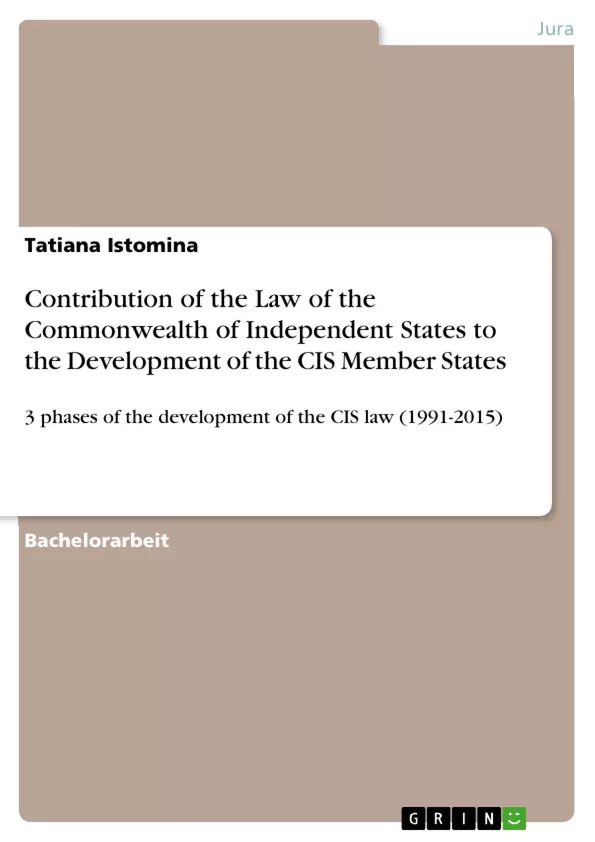The new phase of development of the law of the Commonwealth of Independent States (CIS law) started in 2009, but remains currently unexplored. In general, most research papers have been written about the 1st and 2nd phases, and an insignificant number about the 3rd phase.
The aim of the thesis is to show the contribution which was made and is still being made by the CIS law to the CIS member states’ development at 3 different phases of the existence of this organization, including the new 3rd phase. Moreover, this paper addresses key historical, political and economic factors, with primary emphasis on the analysis of the main legal sources of the CIS. By comparing 3 phases of development of the CIS law, its impact on the development of the CIS States in general is compared, according to the particular phase.
The thesis is divided into two main parts. In the first part the first two phases are combined: first, the historical, economic and legal background is presented for the 1st Phase (2.1.) and for the 2nd Phase (2.2.). Next, the most important legal sources are addressed, and their analysis is conducted (2.3.), and conclusions for the impact of the CIS law on the CIS states are discussed (2.4.). Following this structure, a new phase is addressed in the second part: factors of the CIS law formation (3.1.), the analysis of the basic documents (3.2.) and conclusions about the contribution of the law in respect of the CIS states at the 3rd phase (3.3.). In the fourth part, the results concerning different phases are compared and conclusions are drawn, and additionally the prospects for further development are highlighted.
Inhaltsverzeichnis
- Kapitel 1: Einleitung
- Kapitel 2: 1. und 2. Phase der Entwicklung des GUS-Rechts (1991-2008)
- 2.1. Politischer, wirtschaftlicher und rechtlicher Hintergrund der Entwicklung, 1. Phase
- 2.2. Politischer, wirtschaftlicher und rechtlicher Hintergrund der Entwicklung, 2. Phase
- 2.3. Analyse der relevanten GUS-Rechtsdokumente
- 2.4. Auswirkungen des Rechts auf die Entwicklung der GUS-Mitgliedstaaten (Ergebnisse)
- Kapitel 3: 3. Phase der Entwicklung des GUS-Rechts (2009-2015)
- 3.1. Politischer, wirtschaftlicher und rechtlicher Hintergrund der Entwicklung, 3. Phase
- 3.2. Analyse der relevanten GUS-Rechtsdokumente
- 3.3. Beitrag des Rechts zur Entwicklung der GUS-Mitgliedstaaten (Ergebnisse)
- Kapitel 4: Ergebnisse
Zielsetzung und Themenschwerpunkte
Diese Arbeit untersucht die Entwicklung des Rechts der Gemeinschaft Unabhängiger Staaten (GUS) und dessen Einfluss auf die Entwicklung der GUS-Mitgliedstaaten. Sie analysiert die verschiedenen Phasen der Rechtsentwicklung und beleuchtet die relevanten Rechtsdokumente, die den Prozess der Integration und Kooperation innerhalb der GUS geprägt haben.
- Die politischen, wirtschaftlichen und rechtlichen Rahmenbedingungen der GUS-Entwicklung
- Die Rolle des Rechts im Integrationsprozess der GUS-Mitgliedstaaten
- Die Auswirkungen des GUS-Rechts auf die wirtschaftliche und soziale Entwicklung der Mitgliedstaaten
- Die Herausforderungen und Perspektiven der Weiterentwicklung des GUS-Rechts
Zusammenfassung der Kapitel
- Kapitel 1: Einleitung
Dieses Kapitel führt in die Thematik der Arbeit ein und erläutert die Relevanz des GUS-Rechts für die Entwicklung der Mitgliedstaaten. Es werden die Forschungsfragen und die Methodik der Arbeit vorgestellt. - Kapitel 2: 1. und 2. Phase der Entwicklung des GUS-Rechts (1991-2008)
Dieses Kapitel analysiert die ersten beiden Phasen der Entwicklung des GUS-Rechts. Es werden die politischen, wirtschaftlichen und rechtlichen Rahmenbedingungen dieser Phasen untersucht und die relevanten Rechtsdokumente analysiert. Darüber hinaus werden die Auswirkungen des GUS-Rechts auf die Entwicklung der Mitgliedstaaten in dieser Phase beleuchtet. - Kapitel 3: 3. Phase der Entwicklung des GUS-Rechts (2009-2015)
Dieses Kapitel beschäftigt sich mit der dritten Phase der Entwicklung des GUS-Rechts. Es werden die politischen, wirtschaftlichen und rechtlichen Rahmenbedingungen dieser Phase analysiert, die relevanten Rechtsdokumente untersucht und der Beitrag des Rechts zur Entwicklung der Mitgliedstaaten in dieser Phase bewertet.
Schlüsselwörter
GUS-Recht, Integration, Kooperation, Mitgliedstaaten, Entwicklung, Rechtsdokumente, politische Rahmenbedingungen, wirtschaftliche Rahmenbedingungen, rechtliche Rahmenbedingungen, Ergebnisse.
- Quote paper
- Tatiana Istomina (Author), 2015, Contribution of the Law of the Commonwealth of Independent States to the Development of the CIS Member States, Munich, GRIN Verlag, https://www.grin.com/document/365353



